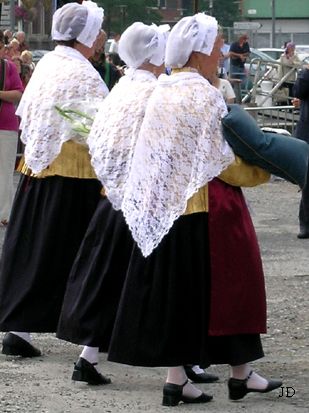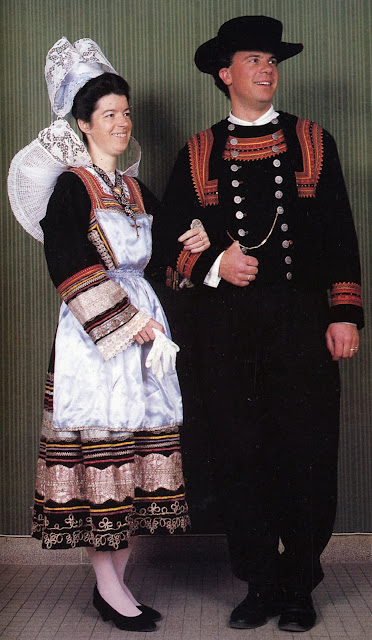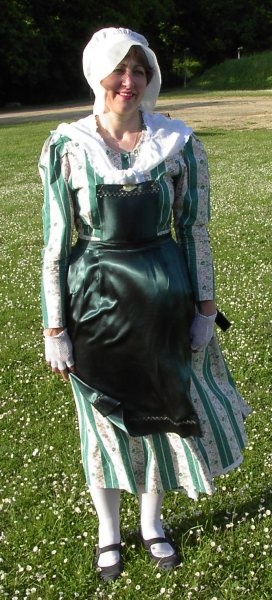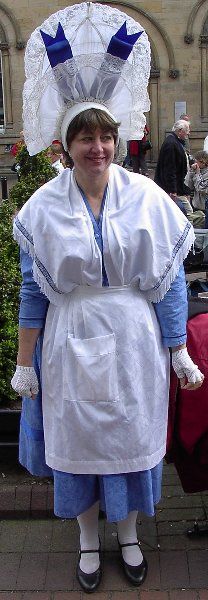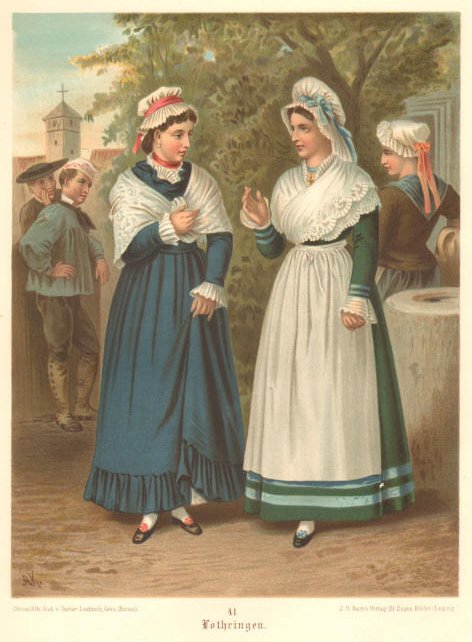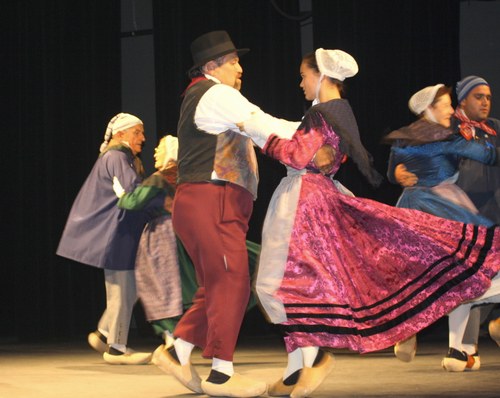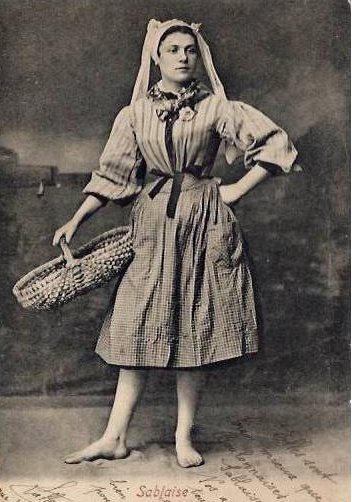Hello all,
Today I will attempt to give an overview of the costumes of France. France was divided into traditional provinces before the revolution. These are shown in color in the map above. Afterwards the nation was divided into administrative districts, called Departements, of roughly the same size, which were grouped into 27 Regions. These are shown by the fine and bold lines on the map above. A quick glance will show that they do not always correspond. The map below names the contemporary Regions and Departements.
I will attempt to present the folk costumes according to the old Provinces, as they more closely present regions of traditional culture.
France is, like most nations, multiethnic and multilingual. The five corners of the nation have territories in which unrelated languages are spoken. German in Alsace, Dutch in French Flanders, Breton in Brittany, Basque in the Basque country, and Catalonian in Rousillon. The Corsican language is also distinct. In the main part of the country various Romance dialects were traditionally spoken, which linguists and tradition group into three languages. In the north, the Langues d'oïl, https://en.wikipedia.org/wiki/Langues_d%27o%C3%AFl
these dialects are various forms of the language which we today call French.
In the east, Arpitan, https://en.wikipedia.org/wiki/Franco-Proven%C3%A7al_language
and in the south, the Langues d'oc, or Occitan. https://en.wikipedia.org/wiki/Occitan_language
On the following map, French dialects are shown in shades of green, Arpitan dialects in shades of blue, and Occitan dialects in shades of red. Other languages are shown in violet or lavender.
This article will cover roughly the territory of the Langues d'oil, with the exception of Aunis and Saintonge. I will proceed roughly from north to south. Some Provinces have much more material as regards costume than others.
Many of the costumes are quite similar, the largest differences being in the coifs and other headdresses, which show an amazing variety.
Flanders
Flanders refers to the Dutch speaking northern part of Belgium. Some of this territory was ceded to France centuries ago, and There are still about 20,000 people in French Flanders who speak Flemish. This area lies on the Belgian border.
https://en.wikipedia.org/wiki/French_Flanders
The ladies of the town of Dunkirk are called Bazennes, and have a distinct costume
A dance from French Flanders
https://www.youtube.com/watch?v=83hqRBo-zv8
Artois
https://en.wikipedia.org/wiki/County_of_Artois
Picardie
https://en.wikipedia.org/wiki/Picardy
One of the most distinctive costumes of Picardie is that of the Pas de Calais, in particular the town of Boulogne sur mer. This is the area along the coast. Currently it has been separated from Picardie and combined with the provinces of Artois and Flandre to form the departement of Nord-Pas de Calais.
Boulogne sur Mer
A parade with street dancing in Boulogne.
https://www.youtube.com/watch?v=pTUybiCsnWA
A few images from other parts of Picardie.
Amiens
Neuville
North Picardie
Normandy
The costumes of Normandy are very famous for their elaborate and large lace and linen headdresses.
https://en.wikipedia.org/wiki/Normandy
A dance from Normandy, showing one of the many famous coifs found in this region.
Brittany
This region is extremely rich in costumes, more than any other. The people are Celtic, and still speak a language related to Welsh and Cornish in the western part, Lower Brittany. In the eastern part, Upper Brittany, this has long been replaced by the Romance dialect of Gallo.
https://en.wikipedia.org/wiki/Brittany
http://folkcostume.blogspot.com/2012/03/overview-of-costumes-and-embroidery-of.html
Bigouden
Kemper
Pont Aven
Rennes
Guerande
A line dance, Fisel, from Brittany.
https://www.youtube.com/watch?v=NGF8IwhojRA
Île-de-France
This is the heart of France, and the modern French Language. This province includes Paris and has long been a world leader of fashion. Because of that, there is little that is remembered of the folk costume.
https://en.wikipedia.org/wiki/%C3%8Ele-de-France
Champagne
This is, of course, the province which is responsible for the classic sparkling wine. In fact, if it does not come from this province, it is not really champagne. As in several other provinces, a high lacy headdress is worn in one of the costumes here.
https://en.wikipedia.org/wiki/Champagne_(historical_province)
https://www.youtube.com/watch?v=BdMmH0HIDfY
Lorraine
This province, like its neighbor Alsace, was contested for a very long time between France and Germany. The north of this province is traditionally German [Allemanic] speaking, while the south spoke dialects related to French. It has been an integral part of France for over a century now.
https://en.wikipedia.org/wiki/Lorraine_(duchy)
A dance from Lorraine.
https://www.youtube.com/watch?v=RIpKXSx6pCk
Alsace
The population of Alsace is overwhelmingly of German origin, but it has been an integral part of France since before the revolution. The traditional language is Allemanic German, but this has been losing ground in the face of the draconian measures instituted by the French government to extinguish minority languages in their country.
https://en.wikipedia.org/wiki/Alsace
I have already done an overview of the costumes of Alsace, but here are a few representative images.
http://folkcostume.blogspot.com/2013/09/overview-of-costumes-of-alsace-or-elsass.html
Oberseebach
Strasburg [Protestant]
Kochersberg [Catholic]
Meistratzheim, lower Alsace
Upper Alsace
A dance from the Strasburg area.
https://www.youtube.com/watch?v=nxajjW29sOA
Franche-Comté
This means the free county of Burgundy. This province was separated from Burgundy proper in the 15th cent.
https://en.wikipedia.org/wiki/Franche-Comt%C3%A9
The costumes of Franche Compte are not well known. One notable costume is that of Montbeliard. Notice the coif embroidered with beads.

Besancon
A tour of the costume museum of Franche Comte. This includes city and historic costume. Folk costumes start about 2/3 of the way through.
https://www.youtube.com/watch?v=m2wXFzAVKrQ
Burgundy
The Dukes of Burgundy were major players in the history of Medieval Europe. They controlled much territory in many far flung places. These are the borders of Burgundy at the time of the French Revolution. Burgundy is, of course, also the home of one of the wold's most famous wines.
https://en.wikipedia.org/wiki/Duchy_of_Burgundy
Morvan
A bouree from Morvan.
https://www.youtube.com/watch?v=6C865X0H7pA
Bresse
I have already done an article on this costume.
http://folkcostume.blogspot.com/2015/02/costume-of-bresse-and-macon-france.html
Video of a historical fair in Bresse. Many costumes are shown. The formal costume shown above shows up at the 12 minute mark.
https://www.youtube.com/watch?v=xTb_Ox8TIvk
Macon
A dance from Macon
https://www.youtube.com/watch?v=_Ooc6-ncInM
Nivernais
This was a small province, and today forms just one departement. The costume of this area is not well known.
https://en.wikipedia.org/wiki/Nivernais
A festival in Nivernais. A medieval group and a Polish group from Rzeszow are also taking part.
https://www.youtube.com/watch?v=4gOOxABF_UA
Bourbonnais
This was a small province. It is part of the French heartland.
https://en.wikipedia.org/wiki/Bourbonnais
This province has a distinct costume, about which I have already done an article. It is symbolized by the famous chapeaux a deux bonjours.
A dance from Bourbonnais.
Berry
Berry lies at the heart of France both geographically and culturally. It is one center of the famous French dance, the bourree.
The costumes of Berry are those of plain country people, perhaps the most typical of all France.
A couple of dances from Berry.
https://www.youtube.com/watch?v=oi3eUTIhGl0
//www.youtube.com/watch?v=Jalol72cMMY
Orléanais
This was the province around the city of Orleans.
https://en.wikipedia.org/wiki/Orl%C3%A9anais
Maine
This province was long caught between the powers of Normandy and Anjou. The costume heritage of this province seems to be poor. If anyone has more information please let me know. Here is some of the little which I have found, most of it from Sarthe.
https://en.wikipedia.org/wiki/Maine_(province)
Anjou
This province has a long history, with many turns and twists.
https://en.wikipedia.org/wiki/Anjou
The coif of Anjou has a very distinct form.
Two very short clips of dances from Anjou.
https://www.youtube.com/watch?v=Vxqt4KepuLE
https://www.youtube.com/watch?v=0ZKKXXb7okE
Touraine
This province took its name from a local Gallic tribe called the Turones. It has been split between 3 different departements since the revolution.
https://en.wikipedia.org/wiki/Touraine
The costumes are rather simple, but there is a distinctive coif in this region called the tourangelle which have beautiful embroidery.
https://www.youtube.com/watch?v=7hgxbCa225U
Poitou
This province is known for fierce independence and resistance to the central government. They have long maintained a strong sense of local identity. This is also the original homeland of the people who became the Cajuns. Echoes of the Poitou dialect still live in the Cajun language.
https://en.wikipedia.org/wiki/Poitou
Poitou was naturally divided into two parts, Upper Poitou and Lower Poitou. Lower Poitou was staunchly Catholic, while upper Poitou was dominated by Huguenots. In modern times the two have been divided, Upper Poitou being joined with Charents to the south, and Lower Poitou was joined with Anjou, Maine and part of Brittany to form a new region known as Pays de la Loire. This gives you some hint of how confusing it can be to research the history of French costume. This is one the richer provinces in terms of costumes and coifs.
Lower Poitou or Le Vendée
As in upper Poitou, there are a variety of costumes, and especially of coifs. I will concentrate on the two most famous costumes of this area.
Le Marais is a marshy area in the south of this area . The inhabitants are known as Maraichains. They have a particularly elegant costume. The men's costume includes a sharp short jacket. The women's apron does not pin to the front, but actually passes over the head.
Here we see that the modern fad of the white wedding dress has penetrated into this costume.
Sables d'Olonne is the main port in this province. There is a unique costume associated with this town, and particularly with those who live near the ocean. The coif is unique, with lacy points.and is worn with a very short skirt. This would be practical for those who often wade in the ocean to do their work.
Like the costume of Bigouden in Brittany, however, this costume continued to develop in the 20th cent. The skirt became even shorter, the petticoat and apron were lost, the skirt became pleated, satins and silks came to be used, and the coif developed a high three sided lace point. This is one of the most famous costumes in France today.
A dance from Sables d'Ollone. The costumes are of the old form, with modern materials.
https://www.youtube.com/watch?v=qKtqATJylQg
Upper Poitou
This is the inland part of Poitou, being physically at a greater elevation. It consists, more or less, of the modern departements of Deux Sevres and Vienne.
In Vienne:
Loudun
Neuville de Poitou
In Deux Sevres
Mothe Saint Herayes
Thouars
Niort
The coif of this area, called grisette, resembles those of further south, in Aunis and Saintonge. I will continue with those costumes in my next article.
Dances from Upper Poitou.
https://www.youtube.com/watch?v=CtjaoWLNU7A
This ends part one. Thank you for reading, I hope that you have found this to be interesting and informative.
Roman K
email: rkozakand@aol.com










